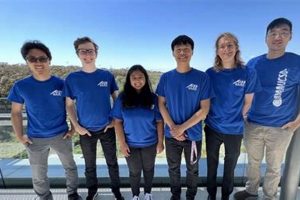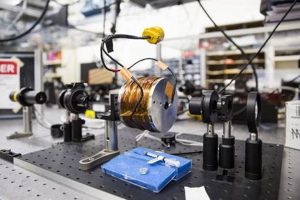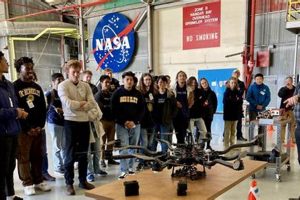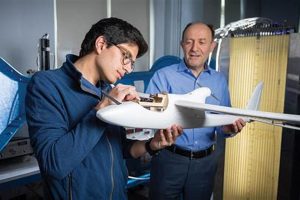Aerospace engineers are responsible for designing, developing, testing, and supervising the manufacture of aircraft, spacecraft, satellites, and missiles. This entails a broad range of activities, from conceptual design and simulations to prototype construction and flight testing. Their expertise is vital for creating efficient, safe, and innovative vehicles that operate within and beyond Earth’s atmosphere. For example, these engineers might design a new commercial airplane wing to improve fuel efficiency or develop guidance systems for interplanetary probes.
The contributions of these professionals are fundamental to advancements in air travel, space exploration, national defense, and scientific research. Improved aircraft designs reduce travel times and fuel consumption, while advancements in spacecraft technology enable deeper insights into the universe and facilitate communication and navigation systems. Historically, their efforts have driven significant technological leaps, from the first powered flight to the Apollo missions, and continue to shape the future of transportation and discovery.
A deeper understanding of the roles and responsibilities these individuals undertake requires examining the specialized areas within the field, including aerodynamics, propulsion systems, structural analysis, and control systems. Furthermore, exploring the necessary education, skills, and technological tools used in their daily work provides a comprehensive overview of this crucial engineering discipline.
Essential Considerations for Aspiring Aerospace Engineers
Individuals pursuing a career focused on aircraft and spacecraft development should prioritize specific strategies to maximize their potential and success within this demanding field.
Tip 1: Emphasize a Strong Foundation in Mathematics and Physics: A rigorous understanding of calculus, differential equations, linear algebra, and physics principles is paramount. These subjects form the bedrock upon which advanced aerospace engineering concepts are built. For example, fluid dynamics, a core aerospace discipline, relies heavily on calculus and differential equations.
Tip 2: Gain Practical Experience Through Internships and Projects: Real-world experience is invaluable. Internships at aerospace companies or research labs offer exposure to industry practices and allow the application of theoretical knowledge. Student-led projects, such as designing and building model airplanes or rockets, provide hands-on learning and develop teamwork skills.
Tip 3: Develop Proficiency in Computer-Aided Design (CAD) and Simulation Software: Modern aerospace engineering relies heavily on software tools for design, analysis, and simulation. Familiarity with programs like CATIA, SolidWorks, ANSYS, and MATLAB is essential for visualizing designs, conducting stress tests, and modeling aerodynamic performance.
Tip 4: Cultivate Strong Communication and Collaboration Skills: Aerospace projects are typically collaborative efforts involving engineers from various disciplines. Effective communication, both written and oral, is crucial for conveying technical information, coordinating tasks, and resolving conflicts within a team.
Tip 5: Focus on Specialization Within Aerospace Engineering: The field is broad, encompassing areas such as aerodynamics, propulsion, structures, control systems, and avionics. Identifying a specific area of interest early on allows for targeted learning and skill development, leading to expertise in a particular domain.
Tip 6: Stay Current with Technological Advancements: The aerospace industry is constantly evolving. Continuously learning about new materials, manufacturing techniques, and technological innovations is essential for maintaining a competitive edge. This can be achieved through attending conferences, reading industry publications, and pursuing continuing education opportunities.
Prioritizing a strong academic foundation, practical experience, and continuous learning will significantly enhance an individual’s prospects within the aerospace engineering field, ultimately contributing to innovation and advancement in air and space travel.
These guidelines serve as a foundation for further exploration into the educational paths, career opportunities, and ongoing challenges within the aerospace sector.
1. Design Aircraft
The design of aircraft constitutes a core function within the domain of aerospace engineering. This process encompasses the application of scientific and engineering principles to create vehicles capable of flight. The responsibility for designing aircraft directly defines a significant portion of what an aerospace engineer does, influencing performance characteristics, safety standards, and operational efficiency. Neglecting this aspect undermines the entire premise of the profession.
Effective aircraft design relies on a thorough understanding of aerodynamics, propulsion, structural mechanics, and materials science. For instance, the creation of a more fuel-efficient commercial airliner mandates the optimization of wing shape to minimize drag, a task directly within the purview of aerospace engineers. The design phase also integrates safety systems and control mechanisms, with engineers analyzing potential failure modes and implementing redundancies to mitigate risk. The development of unmanned aerial vehicles (UAVs) for surveillance or delivery services further exemplifies the practical application of aircraft design principles by these professionals.
In summary, aircraft design is an indispensable element of aerospace engineering. The ability to conceive, model, and refine aircraft configurations directly impacts the advancement of aviation technology and the continued safety and efficiency of air travel. Meeting the challenges of increasingly complex aerospace projects requires highly skilled engineers capable of integrating diverse technical disciplines into innovative and reliable designs.
2. Develop spacecraft
The development of spacecraft represents a critical function inextricably linked to the core responsibilities of an aerospace engineer. This complex undertaking demands a synthesis of diverse engineering principles, scientific knowledge, and innovative design strategies to create vehicles capable of operating in the extreme environments of space.
- Propulsion System Design
The development of spacecraft propulsion systems is paramount for achieving orbital insertion, trajectory adjustments, and interplanetary travel. Aerospace engineers design and optimize rocket engines, including chemical, electric, and nuclear propulsion systems, considering factors such as thrust-to-weight ratio, specific impulse, and reliability. The development of ion thrusters for long-duration missions exemplifies this, enabling efficient and sustained propulsion for deep space exploration.
- Environmental Control and Life Support Systems (ECLSS)
For manned spacecraft, the design and implementation of ECLSS are crucial. Aerospace engineers develop systems to regulate temperature, pressure, and atmospheric composition, as well as provide water and waste management. The International Space Station’s ECLSS, which recycles water and regenerates oxygen, showcases the complexity and necessity of this aspect of spacecraft development.
- Structural Integrity and Thermal Protection
Spacecraft structures must withstand extreme mechanical stresses during launch and the harsh thermal conditions of space. Aerospace engineers employ advanced materials and structural designs to ensure the integrity of the spacecraft, protecting sensitive components from radiation, micrometeoroids, and extreme temperature variations. The heat shield design of the Space Shuttle demonstrates the importance of thermal protection systems for re-entry into Earth’s atmosphere.
- Guidance, Navigation, and Control (GN&C) Systems
Precise navigation and control are essential for spacecraft to reach their intended destinations and maintain stable orientations. Aerospace engineers develop sophisticated GN&C systems using sensors, actuators, and algorithms to guide spacecraft, perform maneuvers, and maintain attitude control. The development of autonomous navigation systems for interplanetary probes highlights the advancements in this area.
These facets underscore the intricate relationship between spacecraft development and the expertise of aerospace engineers. Each element reflects the application of specialized knowledge and innovative problem-solving to overcome the unique challenges of operating in space. The advancement of spacecraft technology directly correlates with the progression of aerospace engineering as a discipline, driving exploration and scientific discovery.
3. Test prototypes
The testing of prototypes constitutes an indispensable element of what an aerospace engineer does, forming a crucial bridge between theoretical design and practical application. This iterative process serves to validate designs, identify flaws, and optimize performance under realistic operating conditions. The consequences of neglecting prototype testing can range from suboptimal performance to catastrophic failure, underscoring its critical role in ensuring the safety and efficacy of aerospace systems. For instance, wind tunnel testing of aircraft wing prototypes allows engineers to measure lift and drag forces accurately, enabling design modifications that enhance fuel efficiency and maneuverability. Similarly, rocket engine prototypes undergo rigorous testing to assess thrust, combustion stability, and structural integrity, preventing potentially disastrous malfunctions during flight.
Effective prototype testing relies on sophisticated instrumentation, data acquisition systems, and simulation techniques. Engineers employ sensors to measure parameters such as pressure, temperature, strain, and acceleration, generating data that is analyzed to assess the prototype’s behavior under various stress conditions. Computational fluid dynamics (CFD) simulations are often used in conjunction with physical testing to provide a comprehensive understanding of aerodynamic performance. The insights gained from prototype testing inform design refinements, material selection, and manufacturing processes, leading to improved performance, reliability, and safety. The development of the Boeing 787 Dreamliner, for example, involved extensive prototype testing of composite materials and aerodynamic configurations to ensure optimal performance and passenger comfort.
In conclusion, prototype testing is an integral and essential facet of the aerospace engineering discipline. The systematic evaluation of prototypes, coupled with meticulous data analysis and iterative design improvements, directly contributes to the creation of safer, more efficient, and more reliable aerospace systems. Addressing the challenges associated with simulating real-world conditions and accurately interpreting test data remains a crucial focus for advancing the field and ensuring the continued success of aerospace endeavors. This critical function underscores the vital role an aerospace engineer plays in transforming concepts into tangible, high-performing aerospace vehicles.
4. Analyze Data
Data analysis forms a cornerstone of what an aerospace engineer does, serving as the critical link between empirical observation and informed decision-making. The ability to extract meaningful insights from raw data directly influences the design, testing, and performance evaluation of aircraft, spacecraft, and related systems. Without rigorous analysis, potential flaws may remain undetected, leading to compromised safety or suboptimal operational efficiency. For example, an aerospace engineer might analyze flight test data to identify unexpected aerodynamic behavior, necessitating design modifications to prevent instability. Similarly, analyzing data from structural stress tests can reveal areas of weakness, guiding material selection and structural reinforcement strategies.
The analysis of data is integral to several core functions within aerospace engineering. In propulsion systems, engineers analyze combustion data to optimize fuel efficiency and reduce emissions. For control systems, data from simulations and flight tests informs the design of algorithms that govern vehicle stability and maneuverability. In materials science, the analysis of fatigue testing data determines the lifespan and reliability of critical components. The consequences of inadequate data analysis are demonstrably significant. For instance, the investigation into the Space Shuttle Challenger disaster highlighted the misinterpretation of data related to O-ring performance at low temperatures, underscoring the crucial need for meticulous and accurate analysis.
The competence in data analysis directly translates to improved designs, safer operations, and enhanced performance in aerospace systems. By extracting actionable insights from complex datasets, engineers can refine designs, optimize operational parameters, and proactively mitigate potential risks. Embracing advanced analytical techniques, such as machine learning and artificial intelligence, offers opportunities for even greater efficiency and accuracy in data interpretation, ultimately contributing to advancements in aerospace technology and exploration. The value of astute data analysis is self-evident in the realm of aerospace where precision and dependability are paramount.
5. Improve efficiency
Enhancing efficiency constitutes a central objective in aerospace engineering. The pursuit of greater efficiency permeates all facets of the field, from aerodynamic design to propulsion systems, directly shaping the activities of aerospace engineers.
- Aerodynamic Optimization
Aerospace engineers continually strive to minimize drag and maximize lift, leading to improved fuel efficiency and enhanced aircraft performance. This involves sophisticated computational fluid dynamics simulations and wind tunnel testing to refine wing shapes, fuselage designs, and control surfaces. For example, the development of winglets on modern aircraft significantly reduces induced drag, resulting in substantial fuel savings over long-haul flights.
- Propulsion System Advancement
Increasing the efficiency of propulsion systems is paramount for reducing fuel consumption and emissions. Aerospace engineers work on developing more efficient jet engines, turboprops, and rocket engines. This includes advancements in turbine blade design, combustion chamber optimization, and the exploration of alternative fuels. The development of more efficient turbofan engines has resulted in significant reductions in fuel burn per passenger mile.
- Structural Weight Reduction
Reducing the weight of aircraft and spacecraft structures is critical for improving performance and fuel efficiency. Aerospace engineers explore the use of advanced composite materials and innovative structural designs to minimize weight without compromising structural integrity. The increasing use of carbon fiber reinforced polymers in aircraft construction has enabled significant weight reductions, leading to improved fuel efficiency and payload capacity.
- Operational Efficiency Enhancements
Aerospace engineers contribute to improving operational efficiency through optimized flight planning, air traffic management systems, and aircraft maintenance procedures. This involves the development of algorithms for optimal routing, the implementation of more efficient air traffic control systems, and the development of predictive maintenance techniques. The implementation of more efficient flight paths and air traffic management systems has led to reduced flight times and fuel consumption.
These interconnected facets highlight the pervasive role of efficiency improvement in aerospace engineering. Through advancements in design, materials, and operational strategies, aerospace engineers continually seek to enhance the performance, reduce the environmental impact, and improve the overall cost-effectiveness of air and space travel. The pursuit of efficiency not only defines much of what an aerospace engineer does, but also drives innovation and progress within the field.
6. Ensure safety
Ensuring safety is paramount in aerospace engineering. This critical responsibility pervades every stage of design, development, testing, and operation. Neglecting safety considerations can lead to catastrophic consequences, underscoring its central role in defining what an aerospace engineer does. Their expertise directly influences the well-being of passengers, crew, and the public at large.
- Rigorous Testing and Simulation
Aerospace engineers employ extensive testing and simulation protocols to identify potential failure points and assess system performance under various conditions. This includes wind tunnel testing, structural analysis, and computational fluid dynamics simulations. For example, engineers simulate extreme turbulence scenarios to evaluate the structural integrity of aircraft wings, preventing potential in-flight failures. These simulations enable proactive identification and mitigation of risks.
- Redundancy and Fail-Safe Systems
Implementing redundant systems is a key strategy for ensuring safety in aerospace applications. Critical components are often duplicated or triplicated, so that if one fails, another can immediately take over. Fail-safe mechanisms are designed to minimize the impact of failures, ensuring that systems default to a safe state. The use of multiple independent flight control systems in commercial aircraft illustrates this principle, guaranteeing continued control even if one system malfunctions.
- Materials Science and Structural Integrity
The selection of materials and the design of structural components are crucial for ensuring the safety of aerospace vehicles. Aerospace engineers conduct rigorous testing to assess the strength, durability, and resistance to fatigue of materials. Advanced materials, such as composites and alloys, are chosen for their high strength-to-weight ratios and resistance to corrosion. The careful selection and testing of materials contribute directly to the structural integrity of aircraft and spacecraft, reducing the risk of catastrophic failures.
- Compliance with Regulations and Standards
Aerospace engineers must adhere to stringent regulations and standards set by governing bodies such as the Federal Aviation Administration (FAA) and the European Aviation Safety Agency (EASA). These regulations cover all aspects of design, manufacturing, and operation, ensuring that aerospace systems meet minimum safety requirements. Compliance with these standards is not merely a bureaucratic formality but a fundamental aspect of ensuring the safety and reliability of aerospace vehicles.
These interwoven elements reveal that safety is not merely a consideration but an intrinsic aspect of what an aerospace engineer does. The application of scientific principles, rigorous testing, and adherence to stringent regulations underscores the profession’s unwavering commitment to safeguarding human life and protecting valuable assets. Continuous improvement in safety protocols and technologies remains a central focus of the discipline, driving innovation and reinforcing public trust in air and space travel.
Frequently Asked Questions About the Aerospace Engineering Profession
This section addresses common inquiries regarding the roles and responsibilities inherent in aerospace engineering, providing factual and objective responses.
Question 1: What specific types of vehicles do aerospace engineers work on?
Aerospace engineers are involved in the design, development, and testing of a diverse range of vehicles, including commercial aircraft, military jets, spacecraft, satellites, missiles, and drones. Their expertise spans both atmospheric and exoatmospheric vehicles.
Question 2: Is a graduate degree required for a successful career in aerospace engineering?
While a bachelor’s degree in aerospace engineering or a related field is typically the minimum requirement, a graduate degree can enhance career prospects and allow for specialization in a specific area. Advanced degrees are often necessary for research and development positions.
Question 3: What are the primary skills needed to excel as an aerospace engineer?
Essential skills include a strong foundation in mathematics and physics, proficiency in computer-aided design (CAD) and simulation software, problem-solving abilities, analytical skills, and effective communication skills. Teamwork and the capacity for continuous learning are also vital.
Question 4: How much mathematics is involved in the daily work of an aerospace engineer?
Mathematics is extensively used in aerospace engineering. Core principles of calculus, differential equations, linear algebra, and statistics are frequently applied in areas such as aerodynamics, structural analysis, and control systems design.
Question 5: What are the common industries that employ aerospace engineers?
Aerospace engineers find employment in various sectors, including aerospace manufacturing companies (e.g., Boeing, Lockheed Martin), government agencies (e.g., NASA, Department of Defense), research laboratories, and consulting firms. Opportunities also exist in the commercial space industry.
Question 6: Is aerospace engineering a good career choice in terms of job security and salary?
Aerospace engineering generally offers strong job security due to the continuous demand for skilled professionals in aviation, space exploration, and defense. Salaries are typically competitive, reflecting the specialized knowledge and technical expertise required.
In summary, a career in aerospace engineering demands a high level of technical proficiency, analytical acumen, and dedication. The field offers diverse opportunities and the potential to contribute to groundbreaking advancements in air and space travel.
The next section will explore the future trends and challenges facing the aerospace engineering profession, providing a forward-looking perspective on the field.
In Conclusion
This exploration has clarified what an aerospace engineer does, detailing responsibilities spanning aircraft and spacecraft design, prototype testing, data analysis, and the relentless pursuit of safety and efficiency. The demonstrated integration of theoretical knowledge with practical application underscores the critical role these professionals play in advancing air and space travel.
As technological frontiers continue to expand, the demand for skilled aerospace engineers will likely persist. Their contributions will remain vital in shaping the future of aviation, space exploration, and national defense, emphasizing the enduring significance of their expertise in an ever-evolving world.







